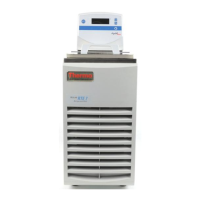
Do you have a question about the Thermo NESLAB RTE Series and is the answer not in the manual?
Details certifications, standards, and directives compliance for the unit.
Information on contacting customer service and required details for support.
Instructions for unpacking and providing feedback on the manual.
Details on the unit's warranty coverage and extended warranty options.
Explains warning symbols and critical safety instructions for operation.
Provides a summary of installation, operation, and maintenance steps.
Overview of the NESLAB RTE Series Bath/Circulators, including technical specs.
Visual representation and physical dimensions for different RTE models.
Guidelines for choosing an appropriate location for the unit, considering environmental factors.
Details grounding, voltage, and power connection requirements for safe operation.
Instructions for hose connections, draining, fluid filling, and fluid types.
Explains the controller interface, buttons, and basic functions for setup and operation.
Procedures for starting, stopping the unit, and managing temperature alarms.
Guide to setting up PID parameters, auto restart, and various operational modes.
Covers external sensors, serial communication, timer, and offset modes for advanced control.
Detailed setup procedures for computer, timer, and offset functions.
Explains adjustable and non-adjustable safety cutouts to prevent overheating.
Lists and describes optional accessories like autorefill, overflow device, and nitrogen purge.
Information on service contracts, reservoir fluid inspection, replacement, and algae control.
Procedures for cleaning the condenser and calibrating temperature sensors.
Instructions for calibrating optional analog input/output ports for data interface.
Lists and explains various error codes, hardware conditions, and functional errors.
Describes the 9-pin D-connector used for optional external sensors.
A systematic guide to diagnose common issues like unit not starting or loss of cooling.
Guidance on seeking service, understanding PID values, BOM, and software version.
Recommendations for water quality to prevent corrosion and ensure unit longevity.
Details compatible fluids, their properties, and potential issues with certain types.
Introduces the RS-232/RS-485 protocol for controlling the unit remotely.
Explains the format of data packets, including framing, addresses, commands, and checksums.
Lists available commands for reading and setting parameters, and expected responses.
Outlines the 24-month warranty period, coverage, exclusions, and limitations.